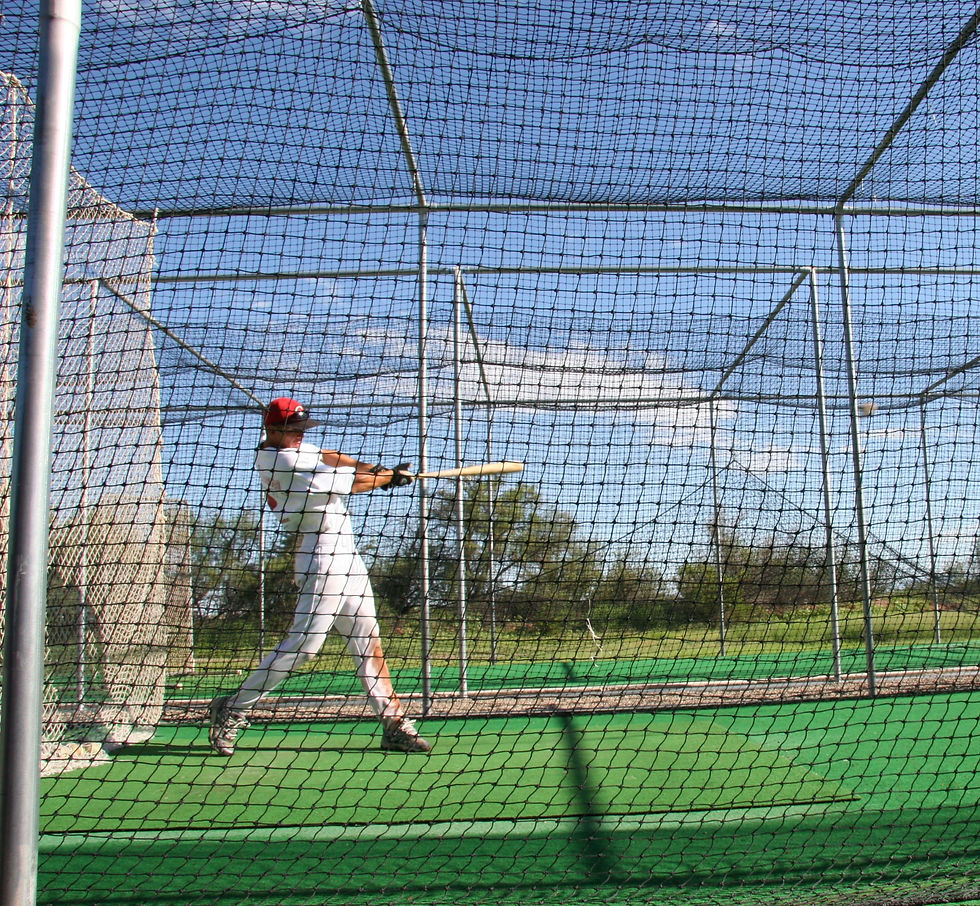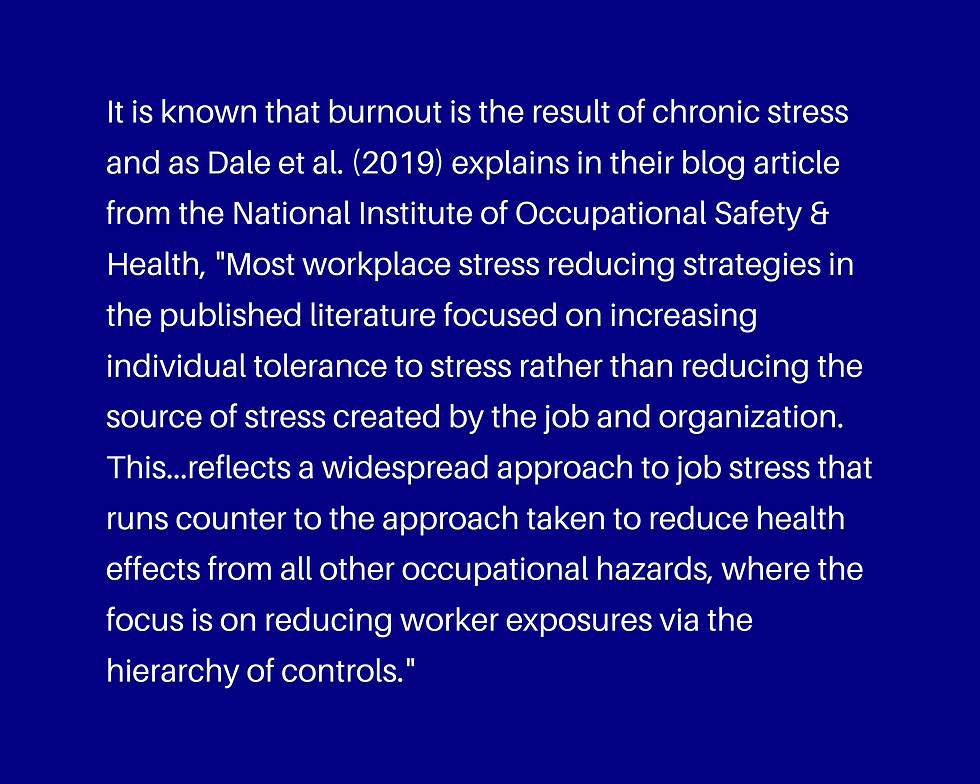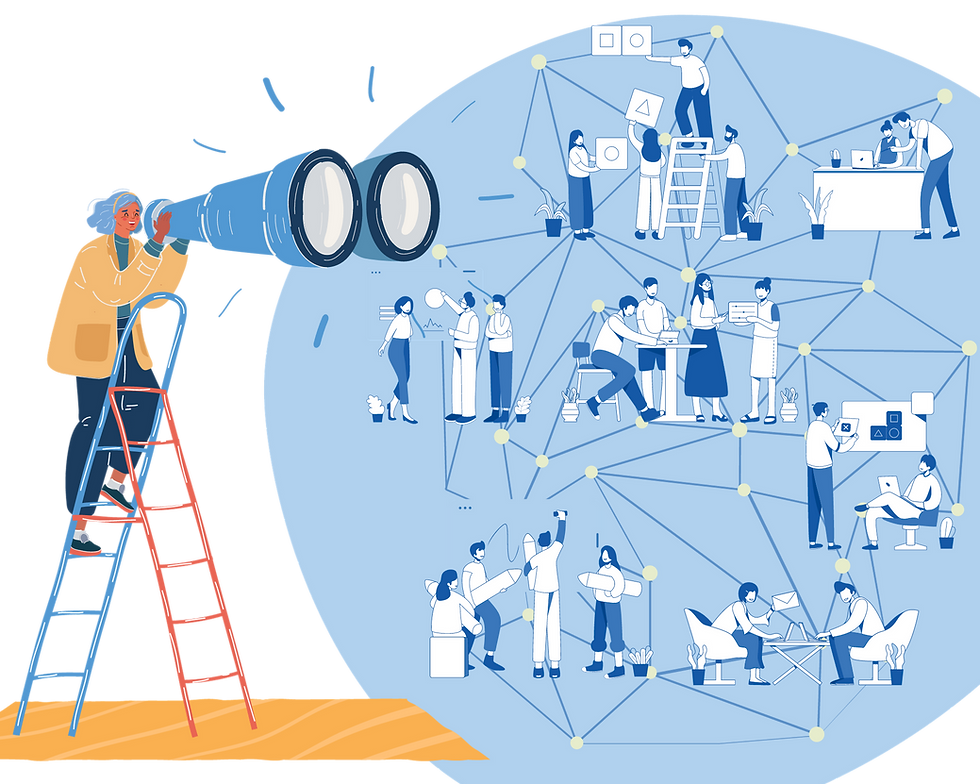Addressing Burnout, Boosting Engagement: The Power of Organizational-Level Strategies
- Tim Bower
- Dec 4, 2023
- 10 min read
Updated: Dec 2, 2024

Many of us find joy in the world of sports, whether through active participation or passionately following our favorite teams. Thinking about the players on your beloved team – can upskilling one or two individuals genuinely transform the overall success, not just of a team, but of an entire organization?
Most amelioration efforts (change strategies) are based upon the assumption that “it is the responsibility of the person, not the organization, to do something about the problem” (Maslach & Goldberg, 1998, p. 66). In other words, the person needs to change and the organization does not need to.
As a devoted Chicago Cubs fan who endured decades of subpar seasons and heartbreak, I can attest that, regardless of how much a few players or the entire team improved their skills and mindsets, my Cubbies still fell short…until the organization-level changes were made and in 2016 we ended a 108-year championship drought. Go Cubs Go.
Rethinking Change: Advocating for a Holistic Approach
There is no denying that individual-level initiatives have their place in a holistic toolkit for change. These initiatives do have merit as they promote agency and can offer relatively immediate yet short-term benefits by reshaping individual mindsets, skills, and behaviors. Even so, their effectiveness falters when it comes to tackling the broader systemic issues deeply embedded in the organizational structure, systems, processes, and procedures.

To help us put this into focus, let’s shift our attention to those individual-level interventions we are more familiar with – the ones aiming to give each employee a little boost in addressing burnout and disengagement. The leaning toward individual-centered prevention, intervention, and change is dominant in the literature and practice and “tend to parallel those for any stress-related disorder” (Farber, 2000, p. 676).
Calling for a Holistic Approach: Beyond Quick Fixes to Sustainable Change
Sure, individual-level approaches do have that desirable fix-the-person, quick-fix vibe, but let's face it – they're not the organizational change superheroes we need.
Despite their potential for immediate impact, research consistently underscores the limitations of these individual-level approaches. The impact of these interventions remains limited in terms of improving workplace experiences and overall organizational improvement (Leiter & Maslach, 2017). Relying on them alone is like bringing a screwdriver to a construction site – useful, but expecting miracles when used alone is wishful thinking. So, relying solely on individual-level initiatives? Not the best move.
What we need is a holistic strategy that addresses both individual and organizational dimensions to get things done right…that is, if our goal is creating the healthy workplace culture and experiences we and our people want. The change initiatives we choose, to address employee burnout and disengagement, for instance, have significant implications for organizational success and employee well-being.
Beyond the Individual: Four Key Advantages Explored
This article briefly highlights four compelling reasons, supported by research, emphasizing why organization-level interventions outshine their individual-level counterparts in effectively tackling the complexities of burnout and disengagement. At the end of this article you will find guiding questions to help you take a critical look at your current strategies for change.
#1 - Inadequate Addressing of Systemic Issues
To reiterate - Most amelioration efforts to address burnout and improve engagement are based upon the assumption that “it is the responsibility of the person, not the organization, to do something about the problem” (Maslach & Goldberg, 1998, p. 66).
As Jennifer Moss (2019) explains in the HBR article Burnout Is About Your Workplace, Not Your People:
“Although developing emotional intelligence skills — like optimism, gratitude, and hope — can give people the rocket fuel they need to be successful, if an employee is dealing with burnout, we have to stop and ask ourselves why. We should never suggest that if they’d just practiced more grit or joined another yoga class or taken a mindfulness course, their burnout would have been avoided."
Focusing on individual-level interventions is like skimming the surface; you're missing the root causes buried in the organizational structure, systems, processes, and procedures. It's akin to fixing a leaky roof by repainting the ceiling—temporary and not hitting the core issues.
“Burnout is best addressed at the organizational level rather than the individual one” (Maslach and Leiter, 1997, p. 72).
Burnout and disengagement are complex issues influenced by systemic factors within the organization. The level of burnout and engagement found in individuals depends on the quality of the work environment (Schaufeli & Enzmann, 1998) and we should focus on “uncovering the characteristics of the bad situations where many good people function” (Maslach, 1978, p. 114).
In addition to providing adequate resources to employees, “[t]he main aim of an organization should be to design the job demands such that people can fulfill them without damaging their health” (Bakker et al. 2005, p. 179).

As such, interventions can be designed to bring about changes in the way the organization works. Maslach advised some 25 years ago – strategies to change the job situation into a more engaging workplace are better than those “strategies of changing the person” (Maslach, 1998, p. 81).
It is no secret and this very important prescription is echoed again and again – Changes are needed “in the ways in which the organization structures, coordinates, and manages the work of its people” in pursuit of goals (Nadler & Tushman, 1999 as cited in Osland & Turner, 2011, p. 641). By not addressing the systemic issues, organizations miss the opportunity to create a real, lasting impact and promote a healthier work environment (Maslach et al., 2001).
#2 - Sustainability Challenges
Changing individual mindsets and behaviors is important, no doubt. But here's the rub – individual-level interventions demand a constant flow of effort and resources to keep their impact alive. Picture it like watering a plant without taking care of the soil. Without corresponding changes at the organizational level, keeping the benefits rolling, if they were realized at all, becomes a real challenge.
This is not a new understanding, nearly four decades ago Peter Brill (1984) found in his research that “interpersonal issues as the primary focus of intervention lead to regressive frustration” and that “interventions focused solely on the interpersonal are almost always doomed to fail” (p. 18).
More recently, Awa et al. (2010) found individual-centered, or person-directed, interventions were short-lived in that they only helped to reduce burnout for six months or less while the “organization-directed interventions” on the other hand had longer lasting effects (12+ months). Demerouti & Bakker’s (2011) research also provided support that employees have a tendency to slip back into old habits that result in burnout and disengagement if the organizational environment remains unchanged.
With many resources dedicated to bringing about change, a focus on sustainability would seem of utmost importance.
#3 - Potential for Inequality
Now, let's talk inequality. Individual-level approaches are a bit like unevenly distributed snacks at a party – some get more, some get less, and maybe some get nothing. They vary in implementation and reach, leading to inconsistent experiences and potentially worsening inequalities within the organization (De Lange et al., 2008; Saks, 2006). It's like playing favorites, and that's not cool.
Flip the script and it is evident organization-level interventions offer a more equitable approach. By addressing systemic factors, they ensure everyone gets a fair share of the good stuff, leveling the playing field (Greenberg, 2017). I can go on and on about this…but, I am sure this focus on inequality and fairness is quite salient for many and does not need a more detailed explanation.
#4 - Lack of Organizational Support
Relying solely on individual-level interventions is a bit like that – placing the burden of change squarely on the employees. It's like saying, "Hey, you fix it," without realizing that organizations hold the strings to a supportive work environment.

Let’s go back to our favorite sports team and imagine them without a coaching staff, where each player is left to devise their own game plan. Some may excel individually and that’s exciting to watch but the lack of a cohesive strategy and shared direction could lead to confusion on the field. Relying solely on individual-level interventions within an organization is like expecting a team to succeed without a coaching staff. Without the organizational support and structures the team will most likely struggle to coordinate efforts, resulting in limited effectiveness and a struggle to create long-lasting improvements (Robertson & Cooper, 2011).
Conclusion
In the quest to address employee burnout and disengagement, individual-level interventions do offer certain advantages, akin to expecting star players to carry the entire team. While they have their merits, it's not merely about upskilling individual players; it's about reshaping the entire game.
The real game-changer lies in acknowledging and addressing the deeper systemic issues embedded in the organizational structure. Embracing organizational-level change initiatives is the key to unlocking the untapped potential of your workforce and sets the stage for sustained, long-term success – build the capacity of the team and the organization so the players can activate their skills and play to their fullest.
Ultimately, the grand slam against burnout and disengagement lies in a holistic approach. This holistic approach acknowledges that individual-level changes and organizational-level changes are not mutually exclusive but rather complementary components of a successful employee engagement and burnout reduction strategy.

A holistic approach transcends the boundaries of individual-level interventions and places priority on making changes to the core elements of the organizational framework – structure, systems, processes, procedures, and practices – to create a dynamic and thriving workplace culture where employees can flourish. In other words, a robust, holistic approach reaches the heart of the matter by addressing root causes, promoting fairness, and nurturing a supportive, healthy culture that not only attracts but retains top-tier talent.
It's high time to break free from conventional thinking about change and wholeheartedly embrace the transformative potential of organizational-level interventions as the driver of the holistic approach…I advocate for the transformative influence of team-level, small-change initiatives on shaping workplace cultures, enhancing overall employee experiences, and boosting organization successes. Read more here.
Now that we've established the need for holistic initiatives, it's time to Assess Your Playbook and take a critical look at your current strategies. Are they solely focused on individual-level interventions, or do they incorporate robust organization-level initiatives?
Here are a few questions to ask yourself:
This is not just an evaluation; it's an opportunity for transformation. Be honest, be bold, and be ready to pioneer a new era of organizational success.
Are We Leveraging Organization-Level Strategies to Address Systemic Issues Contributing to Burnout and Disengagement?
Assess if your organization actively uses strategies at the organizational level – including team-level – to tackle systemic issues linked to burnout and disengagement.
Do Our Approaches Encompass a Holistic View, Considering the Organizational Structure, Systems, Processes, and Procedures?
Reflect on the comprehensiveness of your current approaches. Are they considering the broader organizational landscape, including structure, systems, processes, and procedures, to create a holistic impact?
Are Our Initiatives Addressing Root Causes or Surface-level Symptoms?
Evaluate whether your interventions go beyond immediate symptoms and tackle the root causes of burnout and disengagement, fostering meaningful, lasting change.
Is There Adequate Communication and Feedback Mechanism?
Reflect on communication channels and feedback mechanisms. Are employees actively participating in shaping initiatives, and do they feel heard?
Are We Investing in Skill Development at Both Individual and Organizational Levels?
Examine if your organization invests in development at both individual and collective levels, enhancing team and organizational capabilities.
How Flexible Are Our Strategies in Adapting to Changing Needs?
Assess the flexibility of your strategies. Are they agile and flexible enough to adapt to evolving organizational needs, or are they rigid and resistant to change?
Do Our Strategies Embrace the "Small Change, Big Impact" Philosophy?
Consider whether your strategies are designed to bring about impactful changes through small, targeted incremental adjustments that create a ripple effect, triggering positive outcomes across the organization. Are you leveraging practical and sustainable strategies that yield substantial results with minimal disruption?
Step into the batter's box with our holistic approaches, and hit a home run for lasting transformation—it's your time to shine!
Works Cited:
Awa, W. L., Plaumann, M., & Walter, U. (2010). Burnout prevention: A review of intervention programs. Patient education and counseling, 78(2), 184-190.
Bakker, A. B., Demerouti, E., & Euwema, M. C. (2005). Job Resources Buffer the
Impact of Job Demands on Burnout. Journal of Occupational Health Psychology, 10(2), 170–180.
Brill, P. L. (1984). The need for an operational definition of burnout. Family and Community Health, 6(4), 12–24.
Dale, A. M., Kibby, S., & Buckner-Petty, S. (2019). Exploring individual and organizational stress-reducing interventions across industries. 2019-02-05)[2020-02-10]. https://blogs. cdc. gov/niosh-science-blog/2019/02/05/stress-interventions.
De Lange, A. H., De Witte, H., & Notelaers, G. (2008). Should I stay or should I go? Examining longitudinal relations among job resources and work engagement for stayers versus movers. Work & Stress, 22(3), 201-223.
Demerouti, E., & Bakker, A. B. (2011). The job demands-resources model: Challenges for future research. SA Journal of Industrial Psychology, 37(2), 1-9.
Farber, B. A. (2000). Treatment strategies for different types of teacher burnout. Journal
of Clinical Psychology, 56(5), 675–689.
Greenberg, J. (2017). Positive organizational justice: From fair to fairer—and beyond. In Exploring positive relationships at work (pp. 159-178). Psychology Press.
Leiter, M. P., & Maslach, C. (2017). Banishing burnout: Six strategies for improving your relationship with work. John Wiley & Sons.
Maslach, C. (1978). The client role in staff burn‐out. Journal of social issues, 34(4), 111-124.
Maslach, C. (1998). A Multidimensional Theory of Burnout. In C. L. Cooper (Ed.),
Theories of Organizational Stress (pp. 68-85). Oxford, UK: Oxford University Press.
Maslach C., & Goldberg J. (1998). Prevention of burnout: new perspectives. Applied and
Preventive Psychology, 7(1), 63–74
Maslach, C., Schaufeli, W. B., & Leiter, M. P. (2001). Job burnout. Annual Review of
Psychology, 52, 397-422.
Maslach, C., Schaufeli, W. B., & Leiter, M. P. (2001). Job burnout. Annual Review of Psychology, 52(1), 397-422.
Moss, J. (2019). Burnout is about your workplace, not your people. Harvard Business Review, 1(1), 1-10.
Osland, J., & Turner, M. (2011). The organizational behavior reader. Pearson.
Robertson, I. T., & Cooper, C. L. (2011). Full engagement: The integration of employee engagement and psychological well-being. Leadership & Organization Development Journal, 32(6), 6-11.
Saks, A. M. (2006). Antecedents and consequences of employee engagement. Journal of Managerial Psychology, 21(7), 600-619.
Schaufeli, W. B. & Enzmann, D. (1998). The burnout companion to study and practice:
A critical analysis. London: Taylor & Francis.
Tim Bower is an Empowerment Architect and the key designer behind the 7-HTL framework. As part of a dedicated team of outfitters, he specializes in equipping coaches, mentors, and people developers with the insights, strategies, and tools necessary to inspire transformational leadership. Tim is passionate about empowering others to unlock their potential and create impactful change within their organizations B Optimal
Follow Tim on LinkedIn
Comments